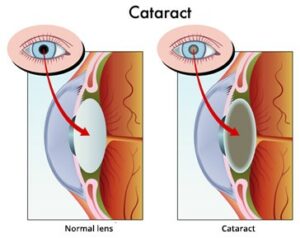Phacoemulsification Cataract Surgery in Yamuna-Nagar Jagadhri
A cataract is cloudiness or opacity of the eye’s natural clear lens. It obstructs the passage of light to the retina (parda) of the eye and impairs vision. When the lens develops cloudiness to the point that it impairs vision, it is called Cataract. It is like looking through a frosted glass.
Cataracts are an ocular condition that occurs when the naturally clear lens of the eye becomes clouded. The condition is more likely to afflict those over the age of 65 and can occur in one or both eyes. Indications of cataracts include general blurriness of vision, sensitivity to light, especially at night while trying to drive, and progressive difficulty reading.
Phacoemulsification, or Phaco: A small incision is made on the side of the cornea, the clear, dome-shaped surface that covers the front of the eye. Your doctor inserts a tiny probe into the eye. This device emits ultrasound waves that soften and break up the lens so that it can be removed by suction. Most cataract surgery today is done by phacoemulsification, also called “small incision cataract surgery.”
What are Cataracts?
 Our eyes act like a camera, taking pictures and sending images to our brains for processing, and just like in a camera, our eyes have lenses. These natural lenses take the light that enters our eyes and bends it, allowing us to see the image being viewed.
Our eyes act like a camera, taking pictures and sending images to our brains for processing, and just like in a camera, our eyes have lenses. These natural lenses take the light that enters our eyes and bends it, allowing us to see the image being viewed.
If a camera’s lens is smudged or dirty and you try to take a picture, the resulting image will be blurry, unclear, or even slightly distorted. This is also true for the lens within your eye.
A cataract is when your eye’s lens becomes cloudy. This clouding prevents light from passing clearly into the retina at the back of your eye, causing blurry, dim, and faded vision.
Cataracts are the leading cause of blindness in the world.
Unfortunately, once you begin to develop cataracts, they will gradually grow more and more noticeable, causing your vision to become worse over time. It is common for cataracts to develop in both eyes, with one often progressing faster than the other.
What Causes Cataracts?
Cataracts are a natural part of the body’s aging process. It is estimated that approximately 70 percent of people have cataracts.
As we age, the proteins within our eye’s lenses begin to break down. This tends to begin around age 40, but usually isn’t until around age 60 that most people begin to notice a clouding in their lenses.
See also: Cataract Symptoms
Cataract Risk Factors
While the normal aging process is the number one cause of cataracts, other factors can increase your risk of developing cataracts, such as:
- Diabetes: Diabetics have an increased chance of developing cataracts.
- Certain medications: Corticosteroids and some phenothiazine-related medications have been linked to cataracts.
- Smoking: Smoking may influence clouding of the eye’s lens.
- High alcohol consumption: There are studies that have found correlations between high alcohol intake and developing cataracts.
- Deficiencies in nutrition: Some studies suggest that low levels of antioxidants correspond with cataract formation.
- Serious infections: It’s possible for cataracts to develop after an individual suffers a severe infection, such as rubella.
- Eye injuries or surgeries: Cataracts may develop after an eye injury or following an eye surgery.
